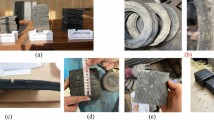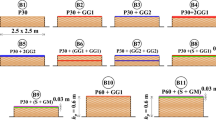Abstract
The performance of a well-designed layer of sand, and composites like layer of sand mixed with shredded rubber tire (RSM) as low cost base isolators, is studied in shake table tests in the laboratory. The building foundation is modeled by a 200 mm by 200 mm and 40 mm thick rigid plexi-glass block. The block is placed in the middle of a 1m by 1m tank filled with sand. The selected base isolator is placed between the block and the sand foundation. Accelerometers are placed on top of the footing and foundation sand layer. The displacement of the footing is also measured by LVDT. The whole setup is mounted on a shake table and subjected to sinusoidal motions with varying amplitude and frequency. Sand is found to be effective only at very high amplitude (> 0.65 g) of motions. The performance of a composite consisting of sand and 50% shredded rubber tire placed under the footing is found to be most promising as a low-cost effective base isolator.
Similar content being viewed by others
References
Ahmed I (1993), “Laboratory Study on Properties of Rubber–soils,” Joint Highway Research Project Report No. 3-36-50L, Indiana Department of Transportation and Department of Civil Engineering, Purdue University, Indiana, USA.
Ahmad S, Ghani F and Adil R (2009), “Seismic Friction Base Isolation Performance Using Demolished Waste in Masonry Housing,” Construct Build Mater., 23(1): 146–152.
Balachowski L and Gotteland P (2007), “Characteristics of Tyre Chips -sand Mixtures from Triaxial Tests,” Arch. Hydro–Eng. Environ. Mech., 54: 25–36.
Doudoumis I, Papadopoulos P and Papaliangas T (2002), “A Low-cost Base-isolation System on Artificial Soil Layers with Low Shearing Resistance,” Proceedings of the 12 European Conference on Earthquake Engineering, London, England.
Edil TB and Bosscher PJ (1994), “Engineering Properties of Tire Chips and Soil Mixtures,” Geotechnical Testing Journal, ASTM, 17(4): 453–464.
Ehrgott RC and Masri SF (1994), “Structural Control Applications of an Electro Rheological Device,” Proceedings of the International Workshop on Structural Control, Univ. of Southern California, Los Angeles, pp. 115–129.
Feng ZY and Sutter K (2000), “Dynamic Properties of Granulated Rubber/Sand Mixtures,” Geotechnical Testing Journal, 23(3): 338–344.
Giri D and Sengupta A (2009), “Dynamic Behavior of Small Scale Nailed Soil Slopes,” Geotech. Geol. Eng., 27: 687–698.
Gray D-H and Ohashi H (1983), “Mechanics of Fiber Reinforcement in Sand,” J. Geot. Engg., ASCE, 112(8): 804–820.
Hazarika H, Yasuhara K, Hyodo M, Karmokar AK and Mitarai Y (2008), “Mitigation of Earthquake Induced Geotechnical Disasters Using a Smart and Novel Geomaterial,” Proceedings of the 14th World Conference on Earthquake Engineering, Beijing, China.
Iai S (1989), “Similitude for Shaking Table Tests on Soil-structure-fluid Model in 1g Gravitational Field,” Soils and Foundations, 29(1): 105–118.
Jangid RS and Datta TK (1995), “Seismic Behavior of Base-isolated Buildings: a State-of-the-art Review,” Proceedings -ICE: Structures & Buildings, 110(2): 186–203.
Kelly JM (1990), “Base Isolation: Linear Theory and Design,” Earthquake Spectra, 6(2): 234–244.
Kelly JM (1996), Earthquake-resistant Design with Rubber, 2nd ed, Springer.
Kirtas E and Pitilakis K (2009), “Subsoil Interventions Effect on Structural Seismic Response, Part II: Parametric Investigation,” Journal of Earthquake Engineering, 13(3): 328–344.
Kirtas E, Rovithis E and Pitilakis K (2009), “Subsoil Interventions Effect on Structural Seismic Response, Part I: Validation of Numerical Simulations,” Journal of Earthquake Engineering, 13(2): 155–169.
Li L (1984), “Base Isolation Measure for Aseismic Buildings in China,” Proceedings of the 8th World Conference on Earthquake Engineering, San Francisco, California, 6, pp. 791–798.
Mavronicola E, Komodromos P and Charmpis DC (2010), “Numerical Investigation of Potential Usage of Rubber-Soil Mixtures as a Distributed Seismic Isolation Approach,” Proceedings of the Tenth International Conference on Computational Structures Technology, Paper 168, Valencia, Spain.
Nagarajaiah S (1997), “Semi-active Control of Structures,” Proceedings of Structures Congress XV, ASCE, Portland, Oregon, pp. 1574–1578.
Nakhaei A, Marandi SM, Sani Kermani S and Bagheripour MH (2012), “Dynamic Properties of Granular Soils Mixed with Granulated Rubber,” Soil Dynamics and Earthquake Engineering, 43: 124–132.
Nanda RP, Agarwal P and Shrikhande M (2012), “Suitable Friction Sliding Materials for Base Isolation of Masonry Buildings,” Journal of Shock and Vibration, 19(6):1327–1339.
Paulay T and Priestley MJN (1992), Seismic Design of Reinforced Concrete and Masonry Buildings, Wiley, New York, New York.
Qamaruddin M and Ahmad S (2007), “Seismic Response of Pure -friction Base Isolated Masonry Building with Restricted Base -sliding,” J. Engg. Res., 4(1): 82–94.
Qamaruddin M, Arya AS and Chandra B (1986), “Seismic Response of Brick Buildings with Sliding Substructure,” Journal of Structural Engineering, 122(12): 558–572.
Ramu M, Prabhu Raja V and Thyla PR (2011), “Development of Structural Similitude and Scaling Laws for Elastic Models,” KSCE Journal of Civil Engineering, 17(1): 139–144.
Senetakis K, Anastasiadis A and Pitilakis K (2012), “Dynamic Properties of Dry Sand/Rubber (SRM) and Gravel/Rubber (GRM) Mixtures in a Wide Range of Shearing Strain Amplitudes,” Soil Dynamics and Earthquake Engineering, 33: 38–53.
Shariatmadari N, Karimpour-Ford M and Roustazadeh M (2007), “Waste Tyre Shreds as Soil Reinforcement,” International Conference on Non-conventional Materials and Technologies: Ecological Materials and Technologies for Sustainable Building, Maceio, Alaqoas, Brazil.
Soong TT (1988), “State-of-the-art Review, Active Structural Control in Civil Engineering,” Engineering Structures, 10(2): 74–84.
Tsang HH (2008), “Seismic Isolation by Rubber-soil Mixtures for Developing Countries,” Earthquake Engineering and Structural Dynamics, 37(2): 283–303.
Tsang HH, Lo SH, Xu X and Sheikh MN (2012), “Seismic Isolation for Low-to-medium-rise Buildings Using Granulated Rubber-soil Mixtures: Numerical Study,” Earthquake Engineering & Structural Dynamics, 41(14): 2009–2024.
Xiong W and Li YZ (2013), “Seismic Isolation Using Granulated Tire-soil Mixtures for Less-developed Regions: Experimental Validation,” Earthquake Engineering & Structural Dynamics, 42(14): 2187–2193.
Yegian MK and Catan M (2004), “Soil Isolation for Seismic Protection Using a Smooth Synthetic Liner,” Journal of Geotechnical and Geo-environmental Engineering, ASCE, 130(11): 1131–1139.
Yegian MK and Kadakal U (2004), “Foundation Isolation for Seismic Protection Using a Smooth Synthetic Liner,” Journal of Geotechnical and Geo-environmental Engineering, ASCE, 130(11): 1121–1130.
Youwai S and Bergado DT (2003), “Strength and Deformation Characteristics of Shredded Rubber Tyre - sand Mixture,” Can. Geotech. J., 40: 254–264.
Author information
Authors and Affiliations
Corresponding author
Rights and permissions
About this article
Cite this article
Bandyopadhyay, S., Sengupta, A. & Reddy, G.R. Performance of sand and shredded rubber tire mixture as a natural base isolator for earthquake protection. Earthq. Eng. Eng. Vib. 14, 683–693 (2015). https://doi.org/10.1007/s11803-015-0053-y
Received:
Accepted:
Published:
Issue Date:
DOI: https://doi.org/10.1007/s11803-015-0053-y




